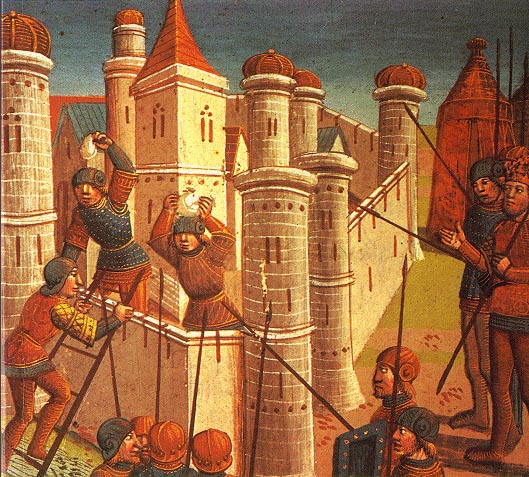loading...
Part 2 of my review of Kenji Lopez-Alt’s Talk, “I’ve Got a Test for That”: Notes from the Keynote at Food Blog South (2013) follows here. In this section, Kenji examines rules of exclusivity that previously dominated twentieth-century models of food writing and publishing. Comparing our new school of food bloggers to “gatekeepers,” Kenji suggests how changing models of accessibility and authority revise the ways we perceive recipes and food writing. As information becomes increasingly available online, the old “gatekeepers” are both removed from their posts and replaced with what Kenji likes to call, “chain-link fences.”
If you’re interested in the two camps I outlined in yesterday’s section (the “Kimballs” versus the “Levines”) read on, or checkout Adam Gopnik’s New Yorker article “How the Internet Gets to Us” on his theory of “Never-Betters” and “Better-Nevers.” Kenji’s advice definitely falls into the latter, “Better-Nevers,” school of thought. —Helana
—
What the Pros Know:
– “Gatekeepers” –
—
As he discussed his own work at Serious Eats, Kenji outlined more than the use-value of new voices and opinions, but the model we base our ideas on in a world of “Kimballs” versus “Levines.”
In the old model, we trusted the chefs.
The new? “Regular folks writing recipes for other regular folks.”
Here, Kenji defines formally-trained and/or corporate chefs as “gatekeepers” to an exclusive society of writers and food knowledge, determining what is written, eaten, or “trendy” in the world of food. Later, newspaper and magazine editors became the gatekeepers, moving expertise out of the kitchen and into the tasting room of any given, well-funded, glossy food pub.

Pictured: image of a Gothic castle with weighty stone walls and barriers to entry. Kenji uses gatekeeper imagery to compare the world of pre-Internet food writing and publishing where those in traditional positions of power (magazine execs, advertisers, glossy pubs with high circulation) bar all but the select few to their ranks.
Kenji articulates this analogy as follows: “the old gatekeepers have been removed from their posts at the gates, but that is in no way the same thing as saying that the walls have been torn down.”
He continues,
“I like to think of it as the walls have been replaced with chain-link fences. We can still see what’s out there trying to get in, and just because the ‘gatekeepers’ have been ‘removed’ from their posts doesn’t mean there’s a flood.”
–Kenji Lopez-Alt
Rather, Kenji sees a “chain-link fence” in which “we are the gatekeepers. We decide who comes in and out of the gates.”

Pictured: page from an illuminated manuscript in which a castle is under siege, and pillagers fight to gain access. Here, individuals outside the kingdom fight for entrance into positions of authority and power defended by stone-throwing guards. Climbing the walls is difficult, but not impossible.
During his talk, I scrawled down notes outlining Kenji’s points, but I failed to understand exactly how he went from “gates” to “chain-link” fences:
I think the simple shift in architecture is pretty compelling—Gothic stone walls exchanged for modern barbed wire.
Plus, “gates” tie in perfectly with the mythic (but highly vulnerable) status Kimball assigned his colleagues with the closing of Gourmet: as old-school editors and food writers, protectors of an exclusive, coveted kingdom, they’re surrounded by what Kimball dubs the “ship of fools,” regularly afraid of villainous attacks by “pirates” or pillagers at any moment.
For editors or publishers wishing to “swim against the tide,” Kenji’s analogy illustrates how highly enforced barriers determine whose voices can be heard in old, twentieth-century models of publishing. But as I was discussing this part of the keynote address with my Editorial & Writing Interns, Erica (deVeer) noted quite aptly,
“but, chain-link fences don’t hold out water; water flows right through them.”
And then Amy (Laws) chimed in, “Perhaps we just need some wire cutters to tear down the fence?”
And Tara (Hebert) added, “Or, maybe, if we’re the fence, then we’re really just standing our ground as the water flows through and around us….”
After a quick pause, I asked,
“So, what does the flowing water represent in this analogy?
Do you think it’s different bloggers’ voices and their user comments? Maybe it’s the larger community of bloggers writing on the Internet in which we’re standing our ground? And Christopher Kimball (and those like him) are ‘swimming against the tide’ because they’re fighting our conversations, or, at least they were in 2009?
. . .and that’s why water flows through this new gate. . .the barbed wiring?”
This was one of those great communal teaching moments in which we all seemed to pause and go: “ahhhhhh. . . .”
Fortunately, Meredith (Quinn) snapped us back to reality—
“You don’t want to have this conversation with English majors! We can dissect anything, especially imagery!”
Hmph. Point taken.
Let’s move on.
—
“Move on” with tomorrow’s installment, Part 3: “The Good, the Bad, and the Plain Weird” from Kenji’s talk, “I’ve Got a Test for That”: Notes from the Keynote, from this year’s Food Blog South Conference (2013).
Directory:
Or, See Part 1: “I’ve Got a Test for That”
Part 2: “Gatekeepers” (above)
Part 3: “The Good, the Bag, & the Plain Weird”
Part 4: “The Architecture of a Good Blog Post”
Part 5: “What Crazy thing Can I Do?”
—
Follow me on Pinterest: http://pinterest.com/helana/
Twitter: https://twitter.com/DancesWLobsters
Facebook: https://www.facebook.com/pages/Clearly-Delicious/103136413059101
Tumblr: http://clearlydelicious.tumblr.com/
Instagram: http://instagram.com/helanabrigman
Part 2: "Gatekeepers," Kenji Lopez-Alt of Serious Eats,

2 Comments
Clearly Delicious » Part 1: “I’ve Got a Test for That,” Notes from the Keynote, Kenji Lopez-Alt of Serious Eats
March 6, 2013 at 7:09 pm[…] « » […]
Clearly Delicious » Part 5: “What Crazy Thing Can I Do?” Kenji Lopez-Alt of Serious Eats
March 18, 2013 at 3:04 am[…] Got a Test for That”: Notes from the Keynote at Food Blog South (2013) ends here (see parts 1, 2, 3, & 4 if you need to catch up). […]